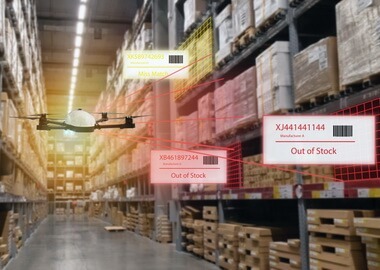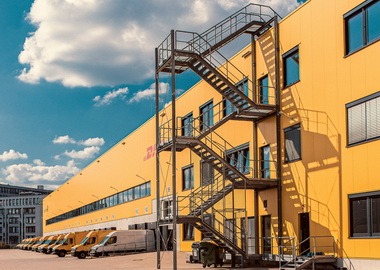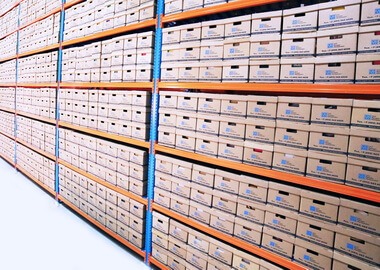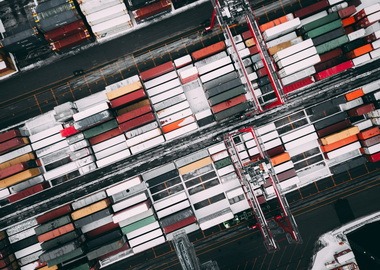How to Use Internet of Things (IoT) in the Retail Industry: Examples, Use Cases and Applications
The retail industry has been riding a wave lately, which can be partly explained by the events related to the pandemic. Amazon.com alone made an incredible leap from an average of 2 billion monthly visitors in 2019 to 2.3 billion in 2020 and a record 2.8 billion in February 2021.
The potential of retail in our digital age is staggering—that said, the industry is aware of its own issues and drawbacks. Changing consumer habits, high pressure on delivery services, buyers’ mistrust in online purchases or lack of tech fluency are all factors that hold sellers back in an environment they could otherwise be thriving in. However, the pandemic has made retailers rethink their strategies and speed up digitization, to a large extent by integrating IoT solutions for retail.
Today’s technology has the capability to break the wall between brand, product, and customer. Many brands have already started turning to IoT in retail which is expected to grow to $94.44 billion through 2025.
What opportunities does technology have to offer? Are there any successful IoT use cases in retail? This post will answer these and other questions and give a complete rundown of IoT implementation in retail.
Internet of Things is the extension of Internet connectivity into physical devices, objects and spaces. The concept of IoT opens a wide range of opportunities in many fields, including transportation, healthcare, workplace, and retail.
These two most common applications of IoT in retail sector give a general idea of how this technology can be used in this space:
- Data gathering and sharing. Using sensors, retail IoT devices, products and environments can collect important data on an entire product and shopping lifecycle. After this data is processed and analyzed, it is transformed into valuable insights that help retail managers make informed decisions and improve retail experience and operations
- Acting based on collected data. IoT-enabled machines and connected stores can be partially or fully automated to drive efficiency, sustainability and resilience to retail operations and processes.
Based on nearly limitless possibilities of Internet of Things for retail, thousands of innovative applications have already been built and successfully integrated into the retail space.
Looking for engineers to help you design and build IoT retail applications? Let’s talk!
How can we help?
Combining the Internet of Things and retail allows store managers to find new ways to establish a connection with customers, create a short and direct customer journey, improve the process of product maintenance, and build a long-lasting bond with first-time shoppers. How to use IoT in retail? Here are several examples of IoT in retail that help improve customer experience.
1. Personalized communications based on IoT-collected data
Internet of Things makes a good case for improving communication between a customer and a brand. In-store IoT sensors can track customers’ journeys, analyze their habits and share insights with the marketing team.
Using this data, content teams can incorporate hyper segmentation practices and create segment-specific content that would help create a personalized shopping experience for every customer, help shoppers to find products, get tips, custom offers and advice, or introduce a friend to the store.
Target uses IoT-based beacons to collect user data and send hyper-personalized content. A visitor can download a Target mobile app for iOS and Android and get product recommendations corresponding to the department they are shopping in. The system of notifications operates like a newsfeed, where all content is sorted by relevance based on the part of the store the user’s exploring. This way, Target successfully shifts the focus to the customer, manages to communicate with in-store visitors more efficiently, and cuts the idle browsing time.
2. Optimizing product usage
All the datum collected by IoT allows brands to improve product maintenance, features, even design. A company can tweak the settings and make necessary updates on a product as a client uses it at home. Moreover, all insights during the run of the product will be collected and transferred back to the company’s server. When it’s time to design a new lineup, all the gathered data will prove useful.
Rolls Royce uses the Internet of Things to improve the maintenance of its aircraft engines. The brand collects data about the state of an engine on a daily basis and alerts clients as soon as there’s a need for active maintenance. This way, end-users can avoid damage while the brand receives important information on product usage to further improve design and performance.
3. Monitor and predict in-store wait times
This is an important benefit of IoT technology in retail in the time of the pandemic. Long lines at cash decks increase the risks associated with COVID-19 and lower customer retention rates. It’s not just the wait that leaves the customer frustrated so much as not being able to predict the amount of time they will spend waiting.
Using IoT in supermarkets allows brands to manage in-store wait times. The technology can provide a store’s employees with data on how long a user has been waiting. Based on these insights, customers are provided with distractions or offered useful activities to make the time in line more tolerable, while employees can deal with the increased traffic.
Disney World has introduced its first IoT-enabled wearable MagicBand to provide guests with better service, manage lines, automate payment and guest management, etc. Today’s MagicBand offers guests a wide range of features for exciting immersive experiences around Disney World and soon also in Disneyland.
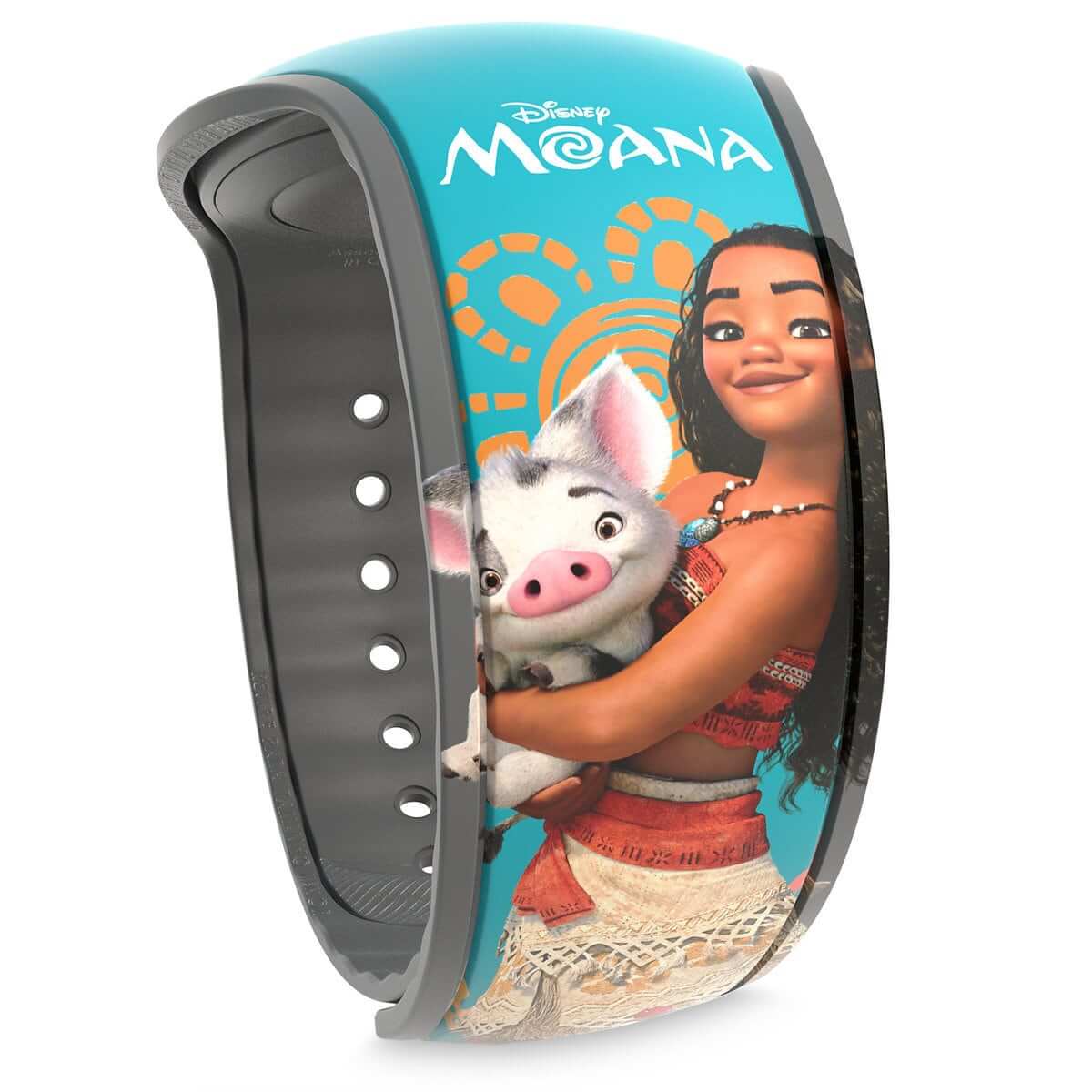
4. Using wearables for loyalty programs
Wearable technology has been a known success for fitness and healthcare. However, wearable IoT application in retail is not limited to tracking location data. In fact, retail companies can benefit from using wearables in many different ways, for example, to identify loyal clients and provide extra services. Hotels use wristbands to identify premium guests and offer bonuses and discount programs for their stay.
Wristbands are a non-invasive way to offer a loyalty program and say ‘thank you’ to those who have supported the brand for a long time.
5. Keep the customer updated on the product delivery status
The demand for delivery has surged during the pandemic and so has the pressure on the delivery services. However, insecurities regarding product delivery time and safety remain. Retail companies use IoT to track orders in real-time and keep customers informed by updating order status on customer web portals of mobile apps.
ParceLive is a shipment tracking service that allows users to monitor parcels in real-time. The company tracks deliveries with built-in GPS trackers and collects data on shipping speed, conditions and location. Using the data from a combination of sensors, the company can even alert clients if their package was dropped or potentially damaged.
Benefits of Data Visualization for Your Business
How to Benefit with Discovery Phase in Software Development
Dedicated Team Model for Your Business: Definition, Approach and Benefits
Software Development Outsourcing Guide: Why, When and How to Start
10 Warehouse Automation Benefits for Your Business
There is a ton of applications of IoT in retail industry for improving customer experience and just about as many in retail management. Here are the main opportunities of the Internet of Things in retail.
Customer experience personalization
Integrating IoT in retail stores is a true way for a brand to foster a personal connection with customers. It goes way beyond pinging a store passersby to pop in. Retailers use smart retail IoT applications to find out more about their customers and lay the groundwork for microtargeting. Using these insights, marketing teams can make data-driven choices and use more focused and cost-efficient advertising.
Interested in the possibilities of IoT in retail business? Let’s have a quick call and discuss how connected technology could help you reach your business objectives. Drop us a line!
How can we help?
Supply chain optimization
The use of IoT in retail industry is tightly connected to GPS and RFID technologies that help brands track products through the entire supply chain process. It gives retailers the visibility they need to monitor product movement, conditions and track location as well as predict a precise delivery time.
The range of applications for IoT in supply chain management is impressive. For instance, managers can test different vendors, vehicles, and delivery routes, collect the data on the process and find the cheapest and safest framework for managing products.
The same stays true for product distribution and delivery to end-users.
Innovating in-store experiences
Implementing IoT in shopping malls and stores brings retailers the data they need to optimize the design of their facilities. Use in-store experience data to better organize store layout, optimize time spent at fitting rooms, create a system of intelligent suggestions, and go as far as to replace human staff with automated technology where possible. Amazon Go is, without a doubt, the most famous and successful example of large-scale IoT implementation for revolutionizing the in-store experience.
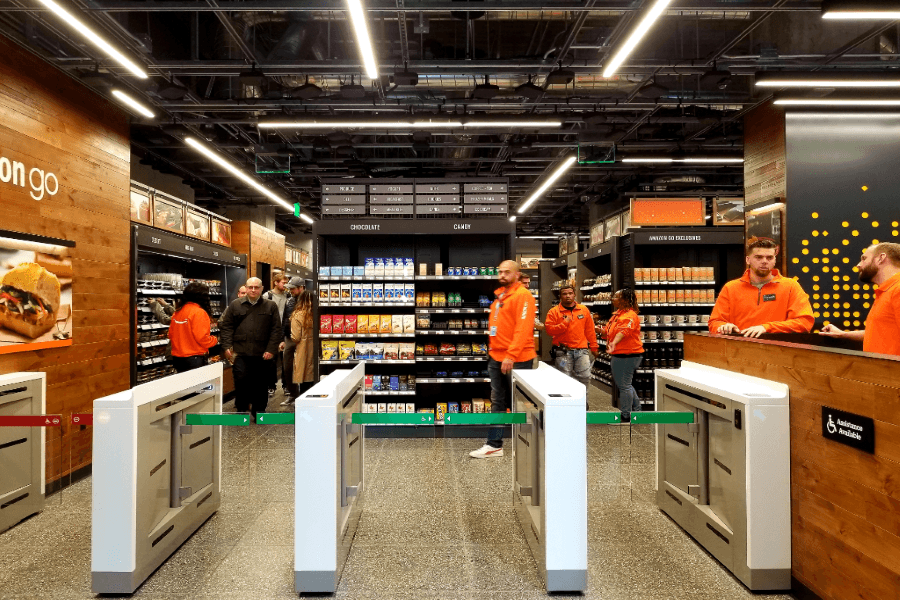
By bringing IoT to physical stores, you’ll be able to cut maintenance costs, increase the speed of service, and eliminate human error.
Increased store management efficiency
The Internet of Things and cloud-based technologies empower a range of solutions that improve the efficiency of business operations in retail. These include:
- Automated packaging services;
- SKU accounting;
- IoT drones for inventory monitoring;
- IoT in facility management.
Implementing IoT for retail management and as a part of warehouse technology results in reducing shrinkage and navigating the inventory easier and supports multiple advantages of warehouse automation.
Decrease the amount of workforce needed for running a store
One of the most effective ways of reducing the amount of workforce involved in store management is automating tasks using robot tech and network solutions. What seemed like something straight out of sci-fi just a few years ago is now commonplace.
Robot employees are widely used at Target supermarkets in order to scan shelves and pinpoint missing items. OSHBot, designed by Lowe’s Innovation Lab, helps users find specific items and answers their questions.
Needless to say, even large-scale use of IoT in retail market won’t eliminate the need for a human workforce entirely. Instead, employees will be able to focus on tasks that are not repetitive and mundane but rather require top-notch human assistance.
Need help with your project?
Check our IoT software development services and contact our team for a free consultation
Now that we have outlined the main opportunities of Internet of Things in retail market, it’s time to go over some the most effective and popular examples. Here are just a few of them.
Location tracking
The Internet of Things solves one of the biggest issues in retail — lack of delivery reliability. The technology is capable of increasing operational efficiencies and improving logistics transparency.
The German supermarket chain Feneberg Lebensmittel uses IoT technology to get visibility on its goods and employees’ movements, both within the warehouse and in transit.
Predictive equipment maintenance
Malfunctioning electric appliances (refrigerator units, for example) can lead to tremendous reputational and monetary losses, and it can send dozens of product units to waste. In order to be updated on store maintenance and take a proactive approach, store managers leverage the capabilities of IoT in retail operations management. The technology is capable of providing real-time equipment monitoring and notifying managers in case of likely malfunctioning.
Outside of the Internet of Things used in retail, predictive equipment maintenance has already been implemented in transportation (Volvo and IBM), manufacturing (Chevron and Microsoft), and utilities (Florida Power Light)
Inventory management
Automated inventory management is one of the key benefits of switching to smart retail using IoT technologies. Managers automate product orders, inventory, reordering, gather and analyze data on popularity and predict consumption. All this results in better precision and hefty savings.
There is no lack of inventory-centered IoT solutions, including:
- MIT Drone Inventory System — an IoT-based drone that monitors inventory in real-time and sends alerts in case there are no available units left.
- Intel Retail Sensor Platform — the RFID antenna scans the number of units on the sales floor and alerts a store manager in case it’s low. The platform has a plug-and-play interface and is easy to adopt and use.
- Lululemon uses RFID-based technology for customer-facing inventory managers. A buyer can conduct a real-time check to ensure the desired product is available at the nearest store.
Shopper mapping and analyzing mall traffic
By placing IoT sensors around the store, managers get a better understanding of the most popular zones and products. User activity heat maps help understand where it’s better to put items for sale, how to optimize store space and layout, and record and trace shopping trends over time.
A technology developed by Prism Skylabs uses the store camera and IoT to create heat maps of a shop’s layout and transfer the data to a dashboard in the form of readable insights.
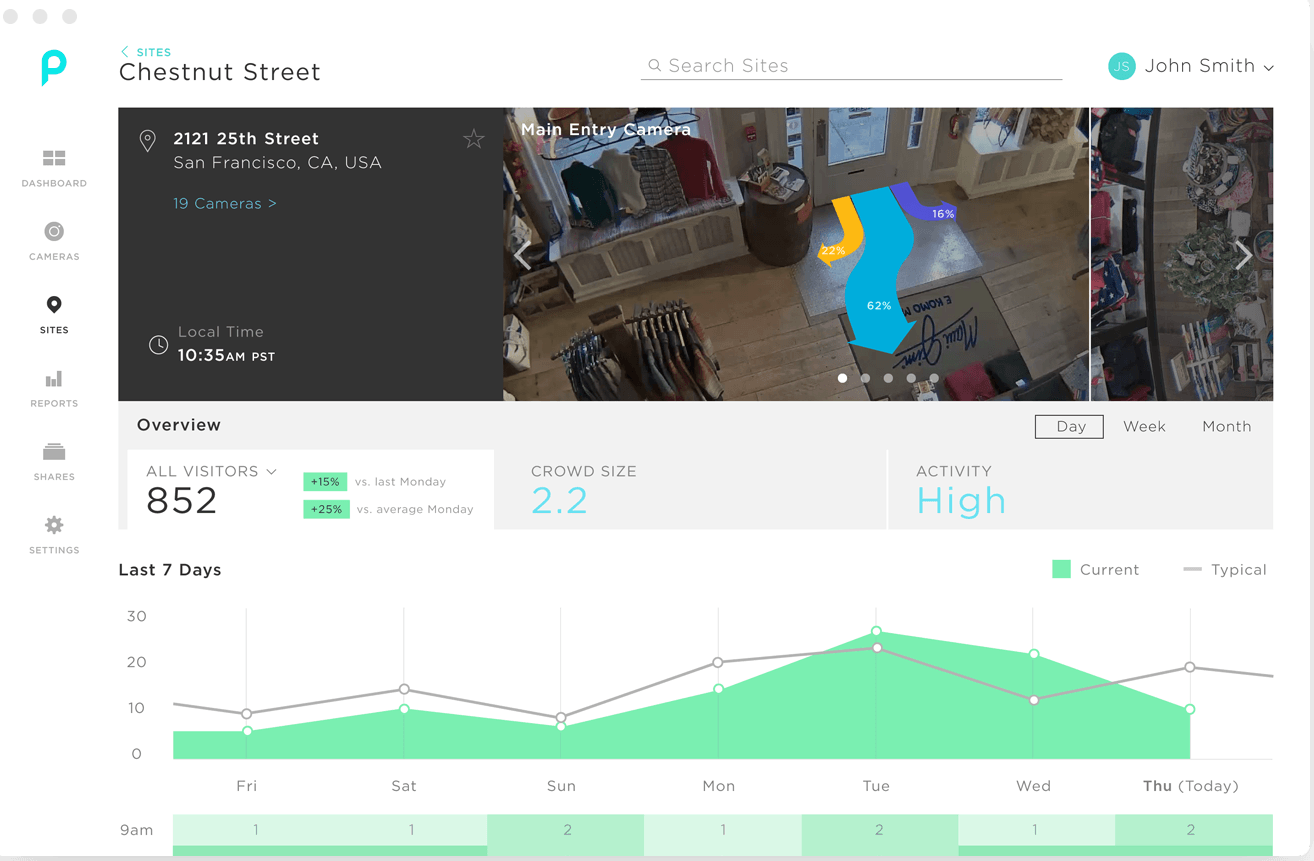
Smart shelves
Smart shelf technology was widely introduced to the retail market when Kroger, the supermarket chain with the highest revenue in the US, tested over 2,000 smart shelves in 2016. Since then, the demand for smart shelving systems has been on a rise, introducing solutions from Perch and AWM for smart shelf management and analytics.
A simple smart shelf has three common elements — an RFID tag, an RFID reader, and an antenna. A microchip on a tag is transferred thanks to the help of an antenna to an IoT platform where it’s processed by a reader. All the data collected by smart shelves during the day will be later shared with a store manager to provide customer-related insights and stock data.
As a stocker walks around the shop with a digital shopping list on their smartphone, the cell phone vibrates in case a needed product is on the shelf nearby. For a better visibility, a shelf in need of more merchandise will light up.
Personalized alerts
IoT-based hyper-personalization is widely used in retail. Geofencing and IoT beacons are both tried-and-true ways to catch a customer’s attention. Here are a few IoT examples in retail that have to do with these technologies:
- Starbucks IoT beacons. Passing by a Starbucks, people would get notifications about new coffee brews or promotions and were invited to visit. According to RT Insights, once introduced, the iBeacon campaign has proven to be highly efficient.
- Avery Dennison personalized shopping experiences by turning clothes labels into RFID tags. These tags give shoppers VIP passes to access bonuses in stores around the town. When Avery Dennison customers are near the stores that offer promotions, they are immediately alerted.
After having conducted a thorough review of Internet of Things in retail industry, let’s go over the benefits of implementing the technology as a part of your own retail business.
Reducing waste and loss
Integrating IoT solutions into retail operations helps reduce costs associated with product waste and loss. Smart retail IoT applications add an additional layer of traceability and visibility to the inventory and delivery processes while also providing better precision and enabling predictability.
Efficient use of in-store staff
Using cameras, retail sensors and tracking technology together with advanced analytics, managers can better understand customer journeys, e.g. identify an impatient or confused shopper, figure out the reasons for an abandoned shopping experience. IoT retail analytics help staff make proactive decisions and adjust the shopping environment.
Optimizing product placement
IoT allows store managers to identify premium store areas, test the placement of different items in those spots, and find the most efficient layout thanks to detailed reports based on the data gathered by sensors.
Improved retail management and tracking
IoT helps store managers be aware of the number of products on the shelves and in the inventory and replenish stocks on time. The technology can also help automate financial management and taxing thus reducing risks of errors and additional costs.
Omnichannel online and in-store experience
Effective IoT strategies for retailers help achieve synergy between eCommerce and in-store experiences. Different applications of the Internet of Things in the retail industry (personalized offers, customer journey tracking, etc.) integrate in-store experience with online digital solutions and help create an omnichannel experience for customers.
Let’s talk about your project!
We can help your develop custom retail IoT solutions for business
The Internet of Things is a key to disrupting modern-day retail. A store manager can increase the quality of consumer connections, improve communications with vendors, cut down operation costs and routine documentation, attract new and retain existing shoppers.
If you’re looking forward to implementing Internet of Things at your own store and need a skilled team to develop a custom software application or build a useful and reliable data solution, reach out to Digiteum. We help businesses integrate the Internet of Things in retail sector by providing a wide range of middleware and software development services.
We have more than a decade-long experience in designing and building digital experiences in eCommerce and retail for startups and enterprise clients. Here are some examples:
- Printique, a US leading photoproduct retailer has been working with Digiteum since 2010. We provide full-cycle eCommerce web portal development and support their high-load customer-facing web platform, as well as tracking and monitoring tools for the entire production line. Learn about our collaboration in this case study.
- We have built several innovative chat and voice-interface solutions for Pan Macmillan to drive sales on Amazon Echo and via messengers and help the retailer meet the needs of a growing audience. Read about Amazon Alexa Skill and Pan Macmillan chatbot.
The Digiteum team has solid experience in IoT software development, big data processing, analytics and visualization technologies. We rely on proactive management and open communication principles, and together, we test and validate our clients’ ideas, dynamically build their systems, and make sure their investment is optimized and well-placed.
To get to know Digiteum better, take a look at our work. To discuss your project, contact our team — we’ll reach out in no time!
How can we help?
FAQ
- Customer journey tracking to improve in-store and online experience and communication
- Product usage monitoring to improve design and performance
- Automated sensor-driven inventory, ordering, shipping and delivery
- Retail data analytics for better targeting and personalized offers


